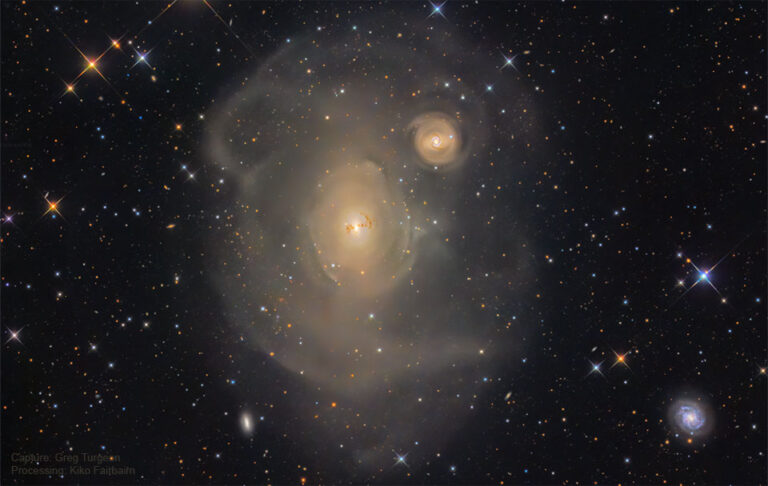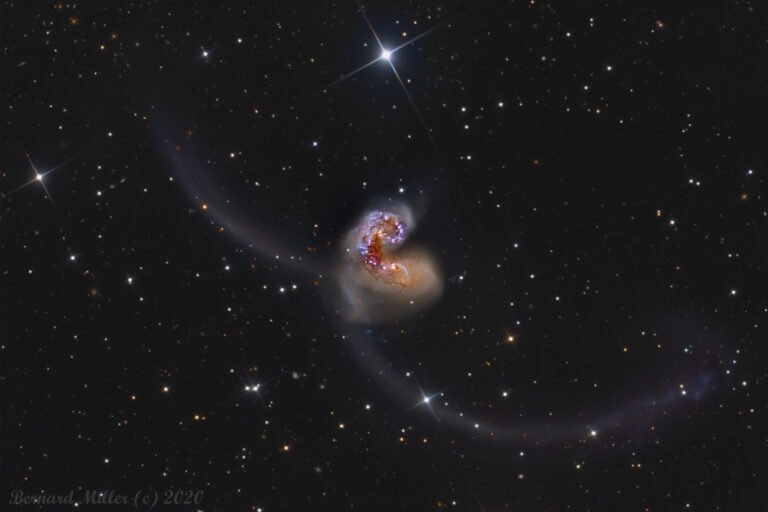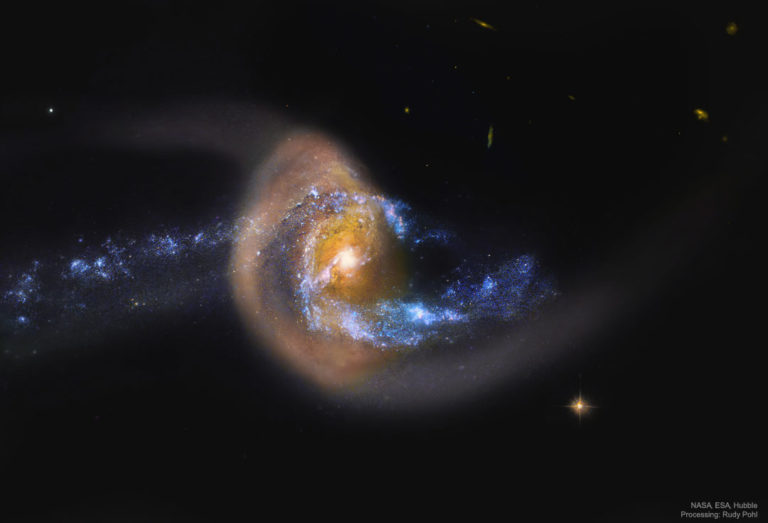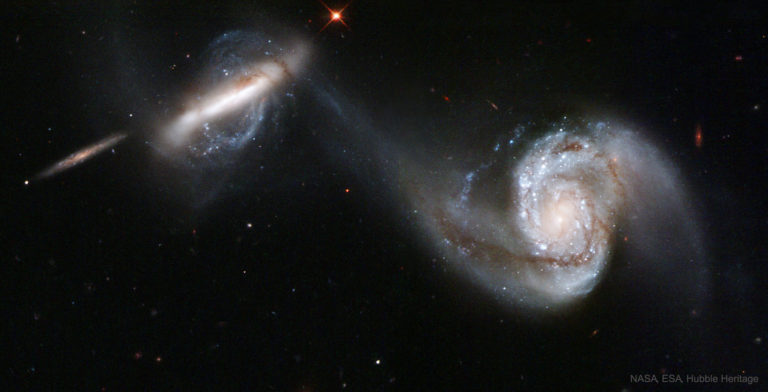马卡莱恩星系链的双眼
图为两个大星系。左边是一个扭曲的螺旋星系,而右边是一个相对没有特征的黄色盘状星系。在某些人看来,这些星系合在一起就像一双眼睛。有关更多详细信息,请参阅说明。

图为两个大星系。左边是一个扭曲的螺旋星系,而右边是一个相对没有特征的黄色盘状星系。在某些人看来,这些星系合在一起就像一双眼睛。有关更多详细信息,请参阅说明。

图中显示的是一个扭曲的星系,左边是一串逐渐消失的恒星。有关更多详细信息,请参阅说明。

2024年2月18日 Hoag’s Object: A Nearly Perfect Ring Galaxy Image Credit: NASA, ESA, Hubble; Processing: Benoit Blanco Explanation: Is this one galaxy or two? This question came to light in 1950 when astronomer Arthur Hoag chanced upon this unusual extragalactic object. On the outside is a ring dominated by bright blue stars, while near the center lies a ball of much redder stars that are likely much older. Between the two is a gap that appears almost completely dark. How Hoag’s Object formed, including its nearly perfectly round ring of stars and gas, remains unknown. Genesis hypotheses include a galaxy collision billions of years ago and the gravitational effect of a central bar that has since vanished. The featured photo was taken by the Hubble Space…

2022年5月17日 NGC 1316: After Galaxies Collide Image Credit & Copyright: Capture: Greg Turgeon; Processing: Kiko Fairbairn Explanation: Astronomers turn detectives when trying to figure out the cause of startling sights like NGC 1316. Investigations indicate that NGC 1316 is an enormous elliptical galaxy that started, about 100 million years ago, to devour a smaller spiral galaxy neighbor, NGC 1317, just on the upper right. Supporting evidence includes the dark dust lanes characteristic of a spiral galaxy, and faint swirls and shells of stars and gas visible in this wide and deep image. One thing that >remains unexplained is the unusually small globular star clusters, seen as faint dots on the image. Most elliptical galaxies have more and brighter globular clusters than NGC 1316. Yet the…

2022年3月31日 Exploring the Antennae Image Credit & Copyright: Dietmar Hager, Eric Benson Explanation: Some 60 million light-years away in the southerly constellation Corvus, two large galaxies are colliding. Stars in the two galaxies, cataloged as NGC 4038 and NGC 4039, very rarely collide in the course of the ponderous cataclysm that lasts for hundreds of millions of years. But the galaxies’ large clouds of molecular gas and dust often do, triggering furious episodes of star formation near the center of the cosmic wreckage. Spanning over 500 thousand light-years, this stunning view also reveals new star clusters and matter flung far from the scene of the accident by gravitational tidal forces. The remarkably sharp ground-based image, an accumulation of 88 hours of exposure captured during 2012-2021,…

2021年03月27日 Exploring the Antennae Image Credit & Copyright: Bernard Miller Explanation: Some 60 million light-years away in the southerly constellation Corvus, two large galaxies are colliding. Stars in the two galaxies, cataloged as NGC 4038 and NGC 4039, very rarely collide in the course of the ponderous cataclysm that lasts for hundreds of millions of years. But the galaxies’ large clouds of molecular gas and dust often do, triggering furious episodes of star formationi near the center of the cosmic wreckage. Spanning over 500 thousand light-years, this stunning view also reveals new star clusters and matter flung far from the scene of the accident by gravitational tidal forces. The remarkably sharp ground-based image includes narrowband data that highlights the characteristic red glow of atomic hydrogen…

2021年01月26日 Central NGC 1316: After Galaxies Collide Image Credit: NASA, ESA, Hubble; Processing & Copyright: Daniel Nobre Explanation: How did this strange-looking galaxy form? Astronomers turn detectives when trying to figure out the cause of unusual jumbles of stars, gas, and dust like NGC 1316. Inspection indicates that NGC 1316 is an enormous elliptical galaxy that somehow includes dark dust lanes usually found in a spiral galaxy. Detailed images taken by the Hubble Space Telescope shows details, however, that help in reconstructing the history of this gigantic tangle. Deep and wide images show huge collisional shells, while deep central images reveal fewer globular clusters of stars toward NGC 1316’s interior. Such effects are expected in galaxies that have undergone collisions or merging with other galaxies…

2020年12月03日 The Antennae Galaxies in Collision Image Credit: ESA/Hubble NASA Explanation: Sixty million light-years away toward the southerly constellation Corvus, these two large galaxies are colliding. The cosmic train wreck captured in stunning detail in this Hubble Space Telescope snapshot takes hundreds of millions of years to play out. Cataloged as NGC 4038 and NGC 4039, the galaxies’ individual stars don’t often collide though. Their large clouds of molecular gas and dust do, triggering furious episodes of star formation near the center of the wreckage. New star clusters and interstellar matter are jumbled and flung far from the scene of the accident by gravitational forces. This Hubble close-up frame is about 50,000 light-years across at the estimated distance of the colliding galaxies. In wider-field views…

2019 October 9 NGC 7714: Starburst after Galaxy Collision Image Credit: NASA, ESA, Hubble Legacy Archive; Processing & Copyright: Rudy Pohl Explanation: Is this galaxy jumping through a giant ring of stars? Probably not. Although the precise dynamics behind the featured image is yet unclear, what is clear is that the pictured galaxy, NGC 7714, has been stretched and distorted by a recent collision with a neighboring galaxy. This smaller neighbor, NGC 7715, situated off to the left of the featured frame, is thought to have charged right through NGC 7714. Observations indicate that the golden ring pictured is composed of millions of older Sun-like stars that are likely co-moving with the interior bluer stars. In contrast, the bright center of NGC 7714 appears to…

2019 August 11 Arp 87: Merging Galaxies from Hubble Image Credit: NASA, ESA, Hubble Heritage Team (STScI, AURA) Explanation: This dance is to the death. Along the way, as these two large galaxies duel, a cosmic bridge of stars, gas, and dust currently stretches over 75,000 light-years and joins them. The bridge itself is strong evidence that these two immense star systems have passed close to each other and experienced violent tides induced by mutual gravity. As further evidence, the face-on spiral galaxy on the right, also known as NGC 3808A, exhibits many young blue star clusters produced in a burst of star formation. The twisted edge-on spiral on the left (NGC 3808B) seems to be wrapped in the material bridging the galaxies and surrounded…